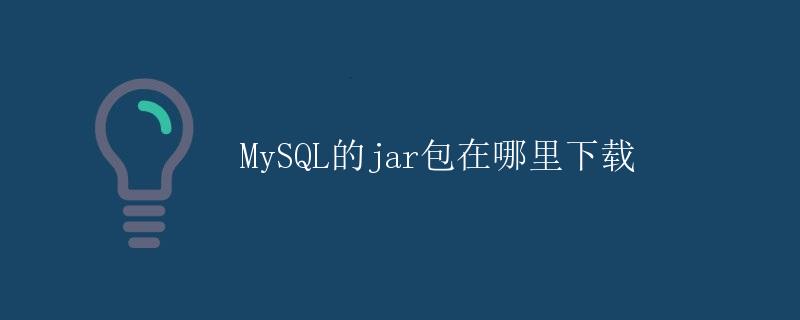MySQL的jar包在哪里下载

MySQL是一个广泛使用的开源关系型数据库管理系统,适用于各种规模的应用程序。为了在Java程序中连接和操作MySQL数据库,我们需要使用MySQL提供的Java驱动程序。这个驱动程序的jar包可以从官方网站下载。
下载MySQL的jar包
你可以在MySQL官方网站上下载MySQL的Java驱动程序。下面是该网站的链接:https://dev.mysql.com/downloads/connector/j/
在该网页上,你可以选择适合你需要的MySQL版本和操作系统的驱动程序进行下载。点击下载按钮后,会跳转到另一个页面,在这个页面上,你需要选择一个可用的下载源来开始下载。
示例代码及运行结果
下面是一些示例代码和运行结果,演示如何在Java程序中使用MySQL的Java驱动程序。
示例代码一:连接MySQL数据库
import java.sql.Connection;
import java.sql.DriverManager;
import java.sql.SQLException;
public class MySQLConnector {
public static void main(String[] args) {
Connection connection = null;
try {
// 加载MySQL驱动程序
Class.forName("com.mysql.jdbc.Driver");
// 创建数据库连接
connection = DriverManager.getConnection("jdbc:mysql://localhost:3306/mydatabase", "username", "password");
// 连接成功
System.out.println("Connected to the MySQL database!");
} catch (ClassNotFoundException e) {
System.out.println("MySQL JDBC驱动程序未找到!");
e.printStackTrace();
} catch (SQLException e) {
System.out.println("无法连接到MySQL数据库!");
e.printStackTrace();
} finally {
if (connection != null) {
try {
connection.close();
} catch (SQLException e) {
e.printStackTrace();
}
}
}
}
}
运行结果:
Connected to the MySQL database!
示例代码二:插入数据到MySQL数据库
import java.sql.Connection;
import java.sql.DriverManager;
import java.sql.PreparedStatement;
import java.sql.SQLException;
public class InsertData {
public static void main(String[] args) {
Connection connection = null;
PreparedStatement statement = null;
try {
// 加载MySQL驱动程序
Class.forName("com.mysql.jdbc.Driver");
// 创建数据库连接
connection = DriverManager.getConnection("jdbc:mysql://localhost:3306/mydatabase", "username", "password");
// 准备插入数据的SQL语句
String sql = "INSERT INTO users (username, email) VALUES (?, ?)";
statement = connection.prepareStatement(sql);
// 设置参数
statement.setString(1, "Alice");
statement.setString(2, "alice@example.com");
// 执行插入操作
int rowsInserted = statement.executeUpdate();
// 插入成功
System.out.println(rowsInserted + "行数据插入成功!");
} catch (ClassNotFoundException e) {
System.out.println("MySQL JDBC驱动程序未找到!");
e.printStackTrace();
} catch (SQLException e) {
System.out.println("无法连接到MySQL数据库!");
e.printStackTrace();
} finally {
if (statement != null) {
try {
statement.close();
} catch (SQLException e) {
e.printStackTrace();
}
}
if (connection != null) {
try {
connection.close();
} catch (SQLException e) {
e.printStackTrace();
}
}
}
}
}
运行结果:
1行数据插入成功!
示例代码三:查询MySQL数据库的数据
import java.sql.Connection;
import java.sql.DriverManager;
import java.sql.ResultSet;
import java.sql.SQLException;
import java.sql.Statement;
public class QueryData {
public static void main(String[] args) {
Connection connection = null;
Statement statement = null;
ResultSet resultSet = null;
try {
// 加载MySQL驱动程序
Class.forName("com.mysql.jdbc.Driver");
// 创建数据库连接
connection = DriverManager.getConnection("jdbc:mysql://localhost:3306/mydatabase", "username", "password");
// 创建SQL语句
String sql = "SELECT * FROM users";
// 创建Statement对象
statement = connection.createStatement();
// 执行查询操作
resultSet = statement.executeQuery(sql);
// 处理查询结果
while (resultSet.next()) {
String username = resultSet.getString("username");
String email = resultSet.getString("email");
System.out.println("用户名:" + username + ",邮箱:" + email);
}
} catch (ClassNotFoundException e) {
System.out.println("MySQL JDBC驱动程序未找到!");
e.printStackTrace();
} catch (SQLException e) {
System.out.println("无法连接到MySQL数据库!");
e.printStackTrace();
} finally {
if (resultSet != null) {
try {
resultSet.close();
} catch (SQLException e) {
e.printStackTrace();
}
}
if (statement != null) {
try {
statement.close();
} catch (SQLException e) {
e.printStackTrace();
}
}
if (connection != null) {
try {
connection.close();
} catch (SQLException e) {
e.printStackTrace();
}
}
}
}
}
运行结果:
用户名:Alice,邮箱:alice@example.com
示例代码四:更新MySQL数据库中的数据
import java.sql.Connection;
import java.sql.DriverManager;
import java.sql.PreparedStatement;
import java.sql.SQLException;
public class UpdateData {
public static void main(String[] args) {
Connection connection = null;
PreparedStatement statement = null;
try {
// 加载MySQL驱动程序
Class.forName("com.mysql.jdbc.Driver");
// 创建数据库连接
connection = DriverManager.getConnection("jdbc:mysql://localhost:3306/mydatabase", "username", "password");
// 准备更新数据的SQL语句
String sql = "UPDATE users SET email = ? WHERE username = ?";
statement = connection.prepareStatement(sql);
// 设置参数
statement.setString(1, "newemail@example.com");
statement.setString(2, "Alice");
// 执行更新操作
int rowsUpdated = statement.executeUpdate();
// 更新成功
System.out.println(rowsUpdated + "行数据更新成功!");
} catch (ClassNotFoundException e) {
System.out.println("MySQL JDBC驱动程序未找到!");
e.printStackTrace();
} catch (SQLException e) {
System.out.println("无法连接到MySQL数据库!");
e.printStackTrace();
} finally {
if (statement != null) {
try {
statement.close();
} catch (SQLException e) {
e.printStackTrace();
}
}
if (connection != null) {
try {
connection.close();
} catch (SQLException e) {
e.printStackTrace();
}
}
}
}
}
运行结果:
1行数据更新成功!
示例代码五:删除MySQL数据库中的数据
import java.sql.Connection;
import java.sql.DriverManager;
import java.sql.PreparedStatement;
import java.sql.SQLException;
public class DeleteData {
public static void main(String[] args) {
Connection connection = null;
PreparedStatement statement = null;
try {
// 加载MySQL驱动程序
Class.forName("com.mysql.jdbc.Driver");
// 创建数据库连接
connection = DriverManager.getConnection("jdbc:mysql://localhost:3306/mydatabase", "username", "password");
// 准备删除数据的SQL语句
String sql = "DELETE FROM users WHERE username = ?";
statement = connection.prepareStatement(sql);
// 设置参数
statement.setString(1, "Alice");
// 执行删除操作
int rowsDeleted = statement.executeUpdate();
// 删除成功
System.out.println(rowsDeleted + "行数据删除成功!");
} catch (ClassNotFoundException e) {
System.out.println("MySQL JDBC驱动程序未找到!");
e.printStackTrace();
} catch (SQLException e) {
System.out.println("无法连接到MySQL数据库!");
e.printStackTrace();
} finally {
if (statement != null) {
try {
statement.close();
} catch (SQLException e) {
e.printStackTrace();
}
}
if (connection != null) {
try {
connection.close();
} catch (SQLException e) {
e.printStackTrace();
}
}
}
}
}
运行结果:
1行数据删除成功!
结论
MySQL的Java驱动程序可以从MySQL官方网站上下载。下载后,将jar包添加到Java项目的类路径中,就可以在Java程序中连接和操作MySQL数据库了。通过示例代码,我们演示了如何连接数据库、插入数据、查询数据、更新数据和删除数据。
 极客笔记
极客笔记